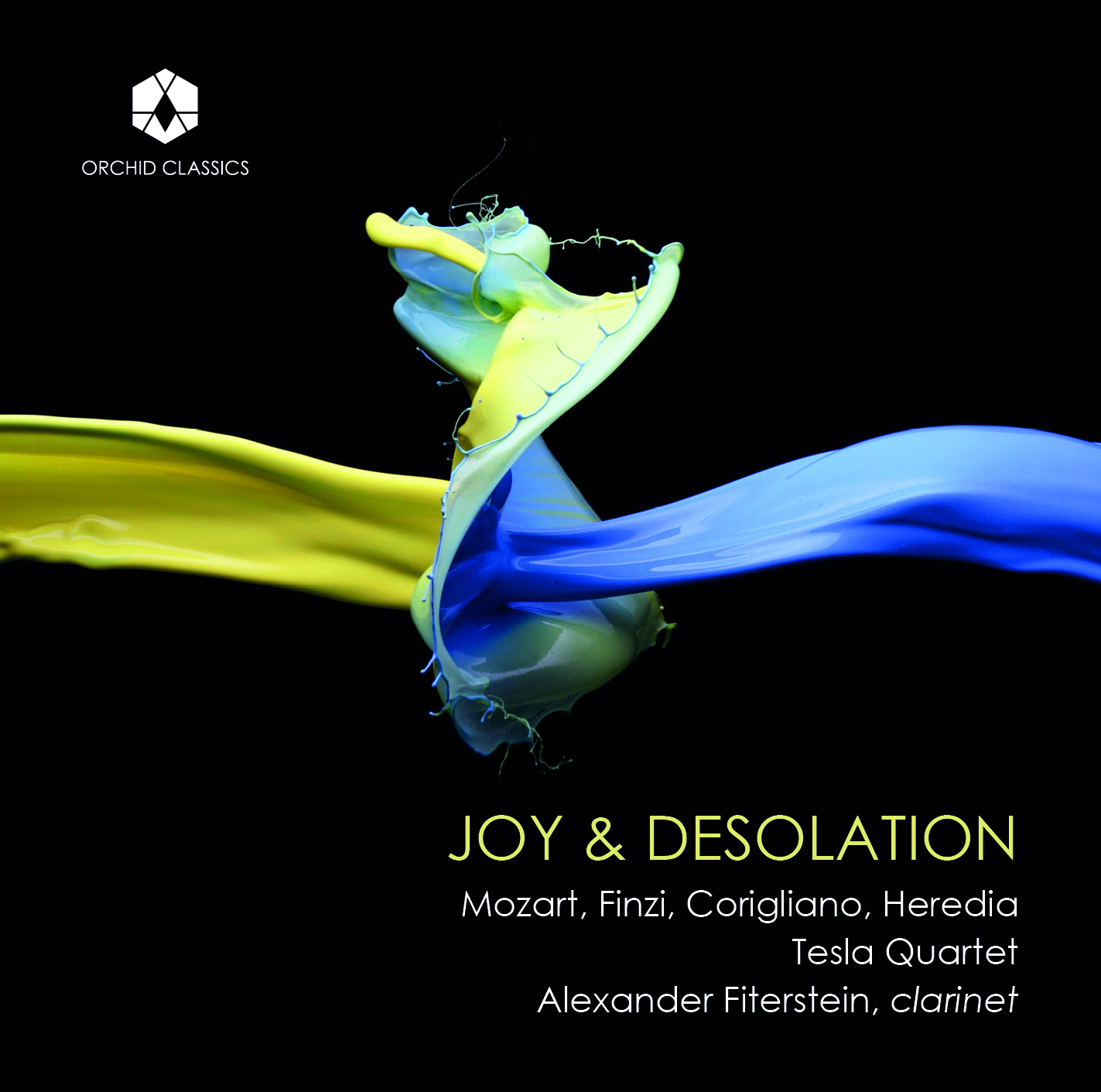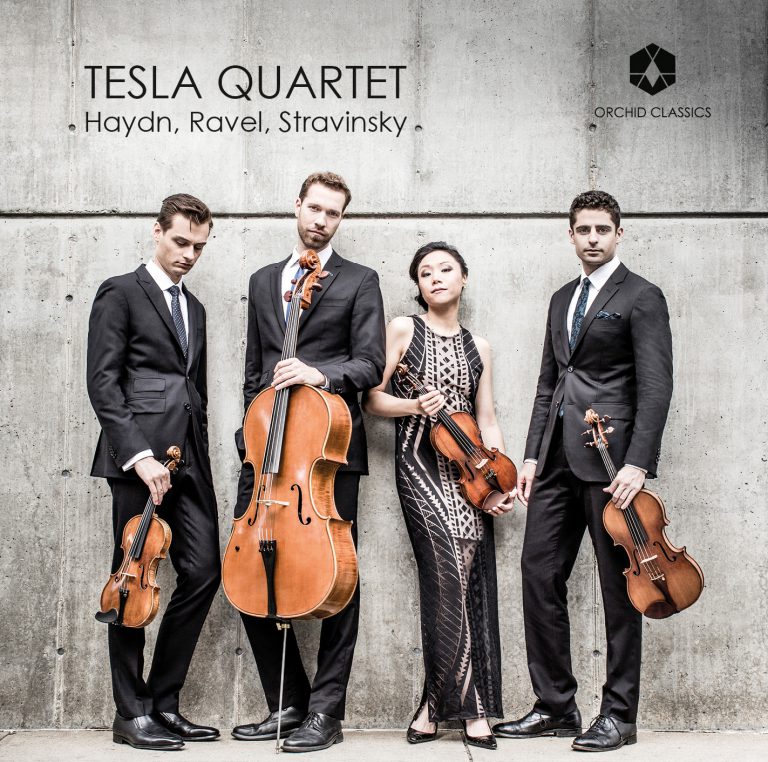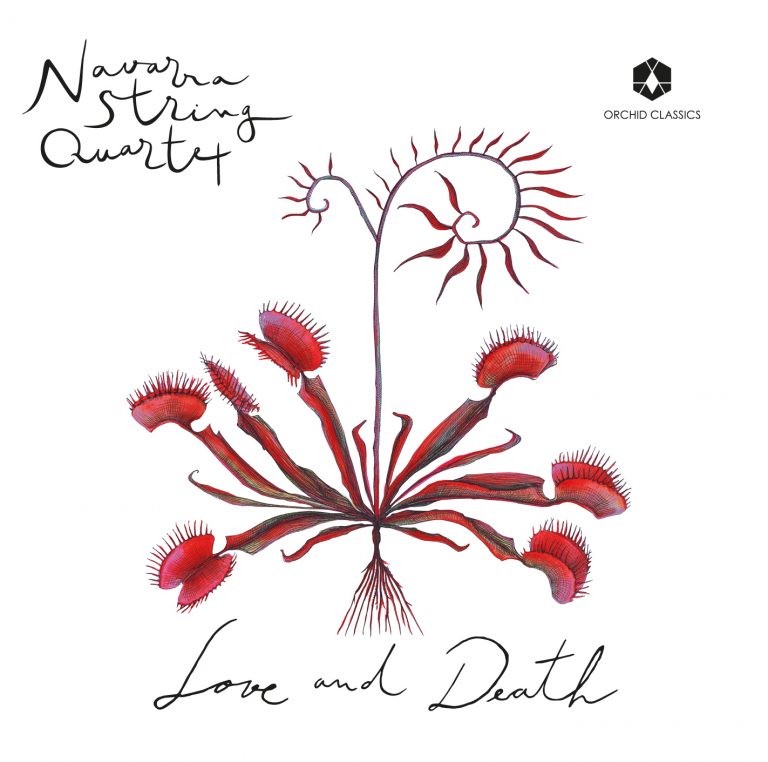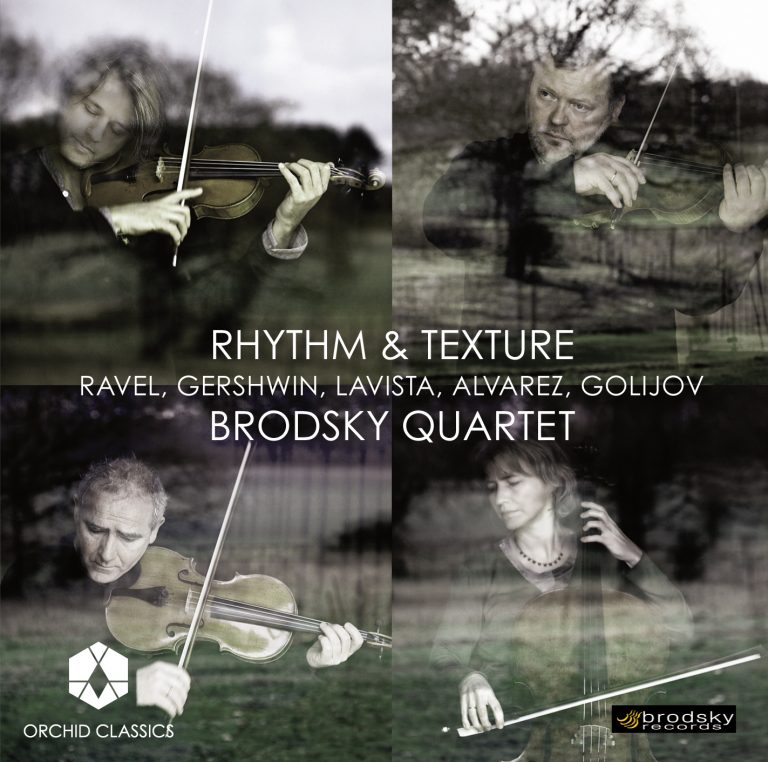Artist Led, Creatively Driven

Joy & Desolation
Tesla Quartet
Alexander Fiterstein, clarinet
Release Date: October 18th 2019
ORC100106
Wolfgang Amadeus Mozart (1756–1791)
Clarinet Quintet in A major, K581†
1 Allegro 9.34
2 Larghetto 6.10
3 Menuetto – Trio 1 – Menuetto – Trio 2 – Menuetto 7.15
4 Allegretto con Variazioni 9.28
Gerald Finzi (1901–1956) arr. Christian Alexander
Five Bagatelles‡
5 Prelude. Allegro deciso 3.41
6 Romance. Andante tranquillo 4.11
7 Carol. Andantino semplice 1.44
8 Forlana. Allegretto grazioso 2.58
9 Fughetta. Allegro vivace 2.23
John Corigliano (b.1938)
10 Soliloquy (1995)†8.32
Carolina Heredia (b.1981)
11 Ius in Bello (2014)‡7.42
Total time 63.38
Alexander Fiterstein (clarinet)
Ross Snyder, Michelle Lie (violins)
Edwin Kaplan (viola)
Serafim Smigelskiy (cello)
† Michelle Lie (violin I), Ross Snyder (violin II)
‡ Ross Snyder (violin I), Michelle Lie (violin II)
“When I am on form, in good shape, as it were… that’s when ideas most readily come to me, in their droves. Where from? How? I have no idea, I can’t help it… The way to turn all these pieces into a good dish comes to me gradually, in accordance with the rules of counterpoint, the timbres of the instruments, and so on. My brain is fired up.”
This, according to Friedrich Rochlitz, is how Mozart described his creative process. Rochlitz was a writer close to Mozart in his final years; how much he embellished the composer’s account is open to speculation, but the description remains powerful. At the heart of Mozart’s creativity is a fascinating contrast between apparently effortless inspiration and disciplined execution, as well as a sensitivity to timbre that would prove essential in his writing for the clarinet.
Mozart first met his fellow-Freemason, the clarinettist Anton Stadler, in 1782, and the two swiftly became friends. Stadler frequently borrowed money, which Mozart could barely afford to lend, but this did nothing to impair Mozart’s admiration for Stadler, whose playing inspired the Clarinet Quintet, as well as a concerto and a trio.
Yet it was not simply Stadler’s ability which Mozart wished to showcase; even before their acquaintance he had expressed admiration for the clarinet itself. This is unsurprising when one considers that Mozart loved playing the viola, often choosing to bring out its warm, deeper tones in his quartet writing; the woodwind equivalent, the clarinet, was sure to hold similar charms. On hearing the famous Mannheim orchestra, Mozart declared: “Ah! If only we too had clarinets! You can’t believe the wonderful effect produced by a symphony with flutes, oboes and clarinets!”
Mozart’s instinctive understanding of the instrument’s capabilities produced exquisite results, with perfect shaping of line and blending of tone. In fact, the instrument for which Mozart was writing was the basset clarinet championed by Stadler, with an extended lower range – perfect for Mozart’s enjoyment of rich, deep sonorities.
Mozart wrote the quintet in 1789, a difficult year: his wife Constanze had been seriously ill, leaving in August to take the cure at Baden. At least some of the sadness this caused can be felt in the more wistful passages of the quintet, which was entered in Mozart’s catalogue on 29 September. The work was first performed at the Society of Musicians’ Christmas concerts on 22 and 23 December of that year, with both Stadler andMozart playing.
The composer called it “Stadler’s Quintet” – and so it is, with ample opportunity for the soloist to display intricate technical mastery. Yet the work’s greatness
lies in the depth with which this skill is expressed: both the slow movement and the finale encompass moments of aching beauty as Mozart wrings every last
drop of lyricism from the instrument’s rich timbre. Hans Keller described this as Mozart’s “simultaneous depth and finished surface, his originality and appeal… his public privacy.”
The Minuet has two trios, the first of which is for strings alone – a felicitous device allowing the soloist a well-earned pause for breath. The joyous finale has, intriguingly, been linked with another masterpiece: Così fan tutte. A fragment of one of Mozart’s sketches contains material probably intended for the quintet, which is used to open Ferrando’s aria “Ah! Lo veggio”. This aria’s text also echoes the quintet’s mood: “in those lovely sighs a sweet ray of hope lights up my heart.”
English composer Gerald Finzi was temperamentally very different from Mozart, and the loss of close family and friends in the First World War consolidated an already introspective nature. But the two composers shared a natural affinity with the clarinet, in Finzi’s case aided by his facility for vocal writing, and a lyricism untarnished by overly sentimental nostalgia or showy technique for its own sake. Finzi’s tendency to rework some of his compositions makes it difficult to give them an exact date. His Five Bagatelles for clarinet and piano, heard here in Christian Alexander’s arrangement for clarinet and string quartet, were begun in the 1920s, but were not finished until the Second World War, when Finzi composed during brief breaks from his work at the Ministry of War Transport. A bagatelle is a short, light piece of music, but in the hands of a fine composer can reach greater depths. Dismissed by Finzi as “only trifles”, three of these bagatelles were complete by 1941, cobbled together, if Finzi’s self-deprecation is to be believed, from “20-year-old bits and pieces”. A fourth piece was added before the premiere in January 1943, given by Pauline Juler and Howard Ferguson at one of the famous wartime National Gallery concerts established by Myra Hess with the assistance of Vaughan Williams. Finzi added a fifth piece, the finale, for the work’s publication as his Op.23 in July 1945, and the set became immediately popular, prompting Finzi to remark that they were “not worth much, but got better notices than my decent stuff”.
The opening Prelude is, like the first movement of Finzi’s Clarinet Concerto, a brisk and breezy movement, its outgoing nature contrasted with a softer central section. The Romance and Carol were probably the earliest written of the bagatelles. An autumnal Romance begins and ends in a spirit of contemplation, thawing during the relaxed central passage. The more animated Carol anticipates the tone of Finzi’s Christmas scene for voices and orchestra, In terra pax. Finzi was a great admirer of J.S. Bach, and his choice of a ‘Forlana’, in a lilting 6/8 meter, may have been influenced by Bach’s use of this Venetian dance style in his Orchestral Suite No.1, BWV1066, or, indeed, by Ravel’s use of the movement in his tribute to friends lost in the First World War, Le Tombeau de Couperin. The final Fughetta is, like the first movement, propelled onwards by a spirit of verve and alacrity, concluding with witty understatement.
Born in New York in 1938, John Corigliano has long espoused a philosophy of inclusiveness in his music, expressing the desire to write for willing performers and audiences. As a consequence, his style often embraces lyricism and tonal harmonies with a flair for theatrical and virtuosic flourishes, sometimes contrasted with modernist techniques. Corigliano’s devastating Soliloquy was composed in 1995 in memory of his late father, who had died in 1975 after a long career as leader of the New York Philharmonic. Corigliano pays tribute to his father’s skill
as a violinist in this piece through intimate dialogue between the first violin and the clarinet.
Soliloquy begins with the violin alone before the other strings are added, setting the scene for the clarinet’s first entry. The pieceis built around two main melodies, for violin and clarinet, in keys a semitone apart, as well as a three-note motif which bridges the gaps between the two themes. Corigliano states that: “The prevailing feeling is that of desolation. I deliberately avoided an emotional climax in the Soliloquy, feeling that sustaining the same mood throughout the music would achieve a heightened intensity.” The work ends with the opening violin line, but this time it is not alone; it is joined by the clarinet.
Argentinian composer Carolina Heredia wrote Ius in Bello in 2014 on commission from the New Music on the Point Festival, held on the shores of Lake Dunmore in Vermont. The title has its roots in international law, in which the concept of ius ad bellum outlines the rules governing the use of force by states, and ius in bello (meaning “law of war”) regulates the nature of hostilities once conflict isunder way. Whilst Heredia was moved by events in Venezuela when composing the work, she was also seeking to reflect on wider moral principles relating to contemporary politics. Musically, Heredia draws upon an array of Latin-American popular styles to addcolour and depth to the work’s tensions, its dream-like quality evoking the heartfelt desire for peace.
© Joanna Wyld, 2019
Tesla Quartet
“Though free to think and act, we are held together, like the stars in the firmament, with ties inseparable. These ties cannot be seen, but we can feel them.” Nikola Tesla
These words are the inspiration behind the Tesla Quartet’s vision. For the quartet, music is the conduit for this incredible, binding force, these “ties inseparable.” Through performance, teaching, and outreach, the Tesla Quartet strives to tap into this palpable feeling and create meaningful connections with their audiences.
Praised for their “superb capacity to find the inner heart of everything they play, regardless of era, style or technical demand” (The International Review of Music), the Tesla Quartet brings refinement and prowess to both new and established repertoire. Dubbed “technically superb” by The Strad, the Tesla Quartet recently took Second Prize as well as the Haydn Prize and Canadian Commission Prize at the 12th Banff International String QuartetCompetition. The quartet won the Gold Medal at the 2012 Fischoff National Chamber Music Competition, and has also garnered top prizes at numerous other international competitions, including 6th International Joseph Haydn Chamber Music Competition in Vienna and the 2012 London International String Quartet Competition. In 2018 the Tesla Quartet released its debut album of Haydn, Ravel, and Stravinsky quartets on the Orchid Classics label to critical acclaim. BBC Music Magazine awarded the disc a Double 5-Star rating and featured it as the “Chamber Choice” for the month of December. Gramophone praised the quartet for its “tautness of focus and refinement of detail.”
The quartet performs regularly across North America, with recent highlights including their debut at New York’s Lincoln Center and performances at Stanford University’s Bing Concert Hall as winners of the prestigious John Lad Prize. Recent international appearances include Austria, Brazil, China, Germany, Hungary, South Korea, and the United Kingdom. Notable festival appearances include the Banff Centre International String Quartet Festival, the Joseph Haydn String Quartet Festival at the Esterházy Palace in Fertőd, Hungary, the Mecklenburg-Vorpommern Festival, and the Festival Sesc de Música de Câmara in São Paulo, Brazil. Having served as the Marjorie Young Bell String Quartet-in-Residence at Mount Allison University in New Brunswick, Canada, from ٢٠١٦–٢٠١٧, the Tesla Quartet also recently completed a four-year community residency in Hickory, North Carolina, that included performances and workshops at local colleges, universities, and in the public school system, as well as a dedicated chamber music series.
The Tesla Quartet was formed at The Juilliard School in 2008 and quickly established itself as one of the most promising young ensembles in New York, winning Second Prize at the J.C. Arriaga Chamber Music Competition only a few months after its inception. From 2009 to 2012 the quartet held a fellowship as the Graduate String Quartet-in-Residence at the University of Colorado-Boulder, where they studied with the world-renowned Takács Quartet. They have also held fellowships at the Aspen Music Festival’s Center for Advanced Quartet Studies, the Britten-Pears Young Artist Programme, and the Norfolk Chamber Music Festival.
Alexander Fiterstein
Clarinetist Alexander Fiterstein is considered one of today’s most exceptional artists. Fiterstein has performed in recital, with distinguished orchestras, and with chamber music ensembles throughout the world. He won first prize at the Carl Nielsen InternationalClarinet Competition and received the prestigious Avery Fisher Career Grant Award. The Washington Post has described his playing as “dazzling in its spectrum of colors, agility, and range. Every sound he makes is finely measured without inhibiting expressiveness” and The New York Times described him as “a clarinetist with a warm tone and powerful technique.”
As soloist he has appeared with the Czech, Israel, Vienna, and St. Paul Chamber Orchestras, Belgrade Philharmonic, Danish National Radio Symphony, Tokyo Philharmonic, China National Symphony Orchestra, KBS Orchestra of South Korea, Jerusalem Symphony, Orchestra of St. Luke’s at Lincoln Center, Kansas City Symphony, and the Simon Bolivar Symphony Orchestra of Venezuela. He has performed in recital on the Music at the Supreme Court Series, the Celebrity Series in Boston, the Isabella Stewart Gardner Museum, the Kennedy Center, the Louvre in Paris, Suntory Hall in Tokyo, Tel Aviv Museum, and New York City’s 92nd Street Y.
A dedicated performer of chamber music, Fiterstein frequently collaborates with distinguished artists and ensembles and regularly performs with the prestigious Chamber Music Society of Lincoln Center. Among the highly regarded artists he has performed with are Daniel Barenboim, Yefim Bronfman, Mitsuko Uchida, Richard Goode, Emanuel Ax, Marc-Andre Hamelin, Pinchas Zukerman, and Steven Isserlis. Fiterstein performed with the Dover, Pacifica, Jerusalem, and Shanghai String Quartets as well as with Ensemble Wien-Berlin. He spent five summers at the Marlboro Music Festival and appeared at the Caramoor, Moab, Music@Menlo, Montreal, Toronto, Jerusalem, and Storioni Chamber Music Festivals.
Fiterstein is a founder of the Zimro Project, a unique ensemble dedicated to incorporating Jewish art music into chamber music programmes. He performed as principal clarinet of the West-East Divan Orchestra at the invitation of Daniel Barenboim and has appeared as guest principal clarinet with the Israel Philharmonic with Zubin Mehta, KBS Orchestra with YoelLevi, and with the St. Paul and Orpheus Chamber Orchestras.
Fiterstein has a prolific recording career and has worked with composers John Corigliano and Osvaldo Golijov and had pieces written for him by Samuel Adler, Mason Bates, Paul Schoenfield, and Chris Brubeck, among others. Fiterstein was born in Belarus and immigrated to Israel at the age of two with his family. A Juilliard graduate, he won first prize at the Young Concert Artists International Auditions and received awards from the America-Israel Cultural Foundation. He is currently Professor of Clarinet and Chair of Winds at the Peabody Institute of the Johns Hopkins University. Fiterstein is a Buffet Crampon and Vandoren Performing Artist.









